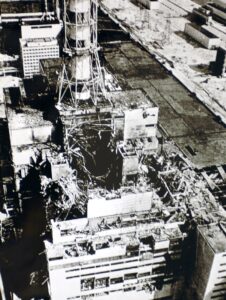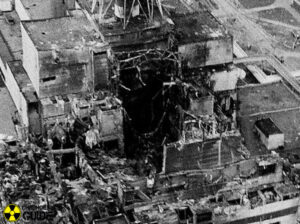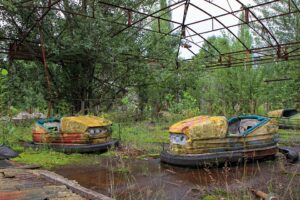 It seems an impossible task, to keep a disaster a secret, and yet that is exactly what the Soviet Union tried to do when disaster struck on April 26, 1986, at the No. 4 reactor in the Chernobyl Nuclear Power Plant, near the city of Pripyat in the north of the Ukrainian SSR. Chernobyl is considered the worst nuclear disaster in history. In terms of cost and casualties, and it is one of only two nuclear energy accidents rated at seven, which is the maximum severity, on the International Nuclear Event Scale. The other disaster was the well known 2011 Fukushima Daiichi nuclear disaster in Japan that was caused by a tsunami.
It seems an impossible task, to keep a disaster a secret, and yet that is exactly what the Soviet Union tried to do when disaster struck on April 26, 1986, at the No. 4 reactor in the Chernobyl Nuclear Power Plant, near the city of Pripyat in the north of the Ukrainian SSR. Chernobyl is considered the worst nuclear disaster in history. In terms of cost and casualties, and it is one of only two nuclear energy accidents rated at seven, which is the maximum severity, on the International Nuclear Event Scale. The other disaster was the well known 2011 Fukushima Daiichi nuclear disaster in Japan that was caused by a tsunami.
On April 28, 1986, two days after monitoring stations in Sweden, Finland and Norway began reporting sudden high discharges of radioactivity in the atmosphere, the Soviet Union finally broke the news by way of their official news agency, Tass. Two days!! In the realm of nuclear contamination, two days is an eternity!! When the Soviet Union finally told the world, Tass simply said there had been an accident at the Chernobyl nuclear power plant in Ukraine. They didn’t say they had tried to hide it, but two days of no response tells me they did. The initial emergency response, together with later decontamination of the environment, ultimately involved more than 500,000 personnel and cost an estimated 18 billion Soviet rubles, which is roughly $68 billion US dollars as of the dollar value in 2019.
It was determined that the accident had started during a safety test on an RBMK-type nuclear reactor. During testing a simulation of an electrical power outage was used to help create a safety procedure for maintaining reactor cooling water circulation until the back-up electrical generators could provide power. These units had been tested three times since 1982, but they had failed to provide a solution. On this fourth attempt, an unexpected 10-hour delay meant that an unprepared operating shift was on duty. The power unexpectedly dropped to a near-zero level during the planned decrease of reactor power in preparation for the electrical test. The operators were only able to partially restore the specified test power, putting the reactor in an unstable condition. This risk was not made evident in the operating instructions, so the operators proceeded with the electrical test. Upon test completion, the operators triggered a reactor shutdown, but a combination of unstable conditions and reactor design flaws caused an uncontrolled nuclear chain reaction instead.
The failure caused a large amount of energy to be suddenly released, followed by two explosions that ruptured  the reactor core and destroyed the reactor building. One was a highly destructive steam explosion from the vaporizing superheated cooling water. The other explosion could have been another steam explosion or a small nuclear explosion, like a nuclear fizzle. The explosions were followed immediately by an open-air reactor core fire that released considerable airborne radioactive contamination for about nine days. The contamination fell onto parts of the USSR and western Europe, especially 10 miles away in Belarus, where around 70% landed, before finally being contained on May 4, 1986. In addition to the contamination released by the explosions, the fire gradually released about the same amount of contamination as did the initial explosion. As a result of rising radiation levels in surrounding regions, a 6.2 mile radius exclusion zone was created 36 hours after the accident. About 49,000 people were evacuated from the area, primarily the citizens of Pripyat. Later the exclusion zone was increased to 19 mile radius, and an additional 68,000 people were evacuated from the wider area.
the reactor core and destroyed the reactor building. One was a highly destructive steam explosion from the vaporizing superheated cooling water. The other explosion could have been another steam explosion or a small nuclear explosion, like a nuclear fizzle. The explosions were followed immediately by an open-air reactor core fire that released considerable airborne radioactive contamination for about nine days. The contamination fell onto parts of the USSR and western Europe, especially 10 miles away in Belarus, where around 70% landed, before finally being contained on May 4, 1986. In addition to the contamination released by the explosions, the fire gradually released about the same amount of contamination as did the initial explosion. As a result of rising radiation levels in surrounding regions, a 6.2 mile radius exclusion zone was created 36 hours after the accident. About 49,000 people were evacuated from the area, primarily the citizens of Pripyat. Later the exclusion zone was increased to 19 mile radius, and an additional 68,000 people were evacuated from the wider area.
When the reactor exploded, two of the reactor operating staff lost their lives instantly. Crews rushed to put out the fire, stabilize the reactor, and cleanup the ejected nuclear core. As a result of the disaster and immediate response, 134 station staff and firemen were hospitalized with acute radiation syndrome due to absorbing high doses of ionizing radiation. In the days to months afterward 28 of these 134 people died, and approximately 14 suspected radiation-induced cancer deaths followed within the next 10 years. Significant cleanup operations were taken in the exclusion zone to deal with local fallout, and the exclusion zone was made permanent. The cities in the zone remain abandoned.
By 2011, an excess of 15 childhood thyroid cancer deaths were documented among the wider population. The United Nations Scientific Committee on the Effects of Atomic Radiation (UNSCEAR) has reviewed all the published research on the incident multiple times, and found that at present, fewer than 100 documented deaths are likely to be attributable to increased exposure to radiation. Of course, there is no way to be sure of that information, because “determining the total eventual number of exposure related deaths is uncertain based on the linear no-threshold model, a contested statistical model, which has also been used in estimates of low level radon and air pollution exposure.” When the expected deaths is viewed in “model predictions with the greatest confidence values of the eventual total death toll in the decades ahead from Chernobyl releases vary, from 4,000 fatalities when solely assessing the three most contaminated former Soviet states, to about 9,000 to 16,000 fatalities when assessing the total continent of Europe. In an effort to reduce the spread of radioactive contamination from the wreckage and protect it from weathering, the protective Chernobyl Nuclear  Power Plant sarcophagus was built by December 1986. It also provided radiological protection for the crews of the undamaged reactors at the site, which continued operating. Due to the continued deterioration of the sarcophagus, it was further enclosed in 2017 by the Chernobyl New Safe Confinement, a larger enclosure that allows the removal of both the sarcophagus and the reactor debris, while containing the radioactive hazard. Nuclear clean-up is scheduled for completion in 2065.” It is my opinion that if they had acted immediately to evacuate the people in surrounding areas, they might have reduced the number of deaths substantially. Keeping the accident a secret for two days was insane, and very likely criminal.
Power Plant sarcophagus was built by December 1986. It also provided radiological protection for the crews of the undamaged reactors at the site, which continued operating. Due to the continued deterioration of the sarcophagus, it was further enclosed in 2017 by the Chernobyl New Safe Confinement, a larger enclosure that allows the removal of both the sarcophagus and the reactor debris, while containing the radioactive hazard. Nuclear clean-up is scheduled for completion in 2065.” It is my opinion that if they had acted immediately to evacuate the people in surrounding areas, they might have reduced the number of deaths substantially. Keeping the accident a secret for two days was insane, and very likely criminal.


Leave a Reply